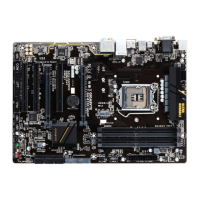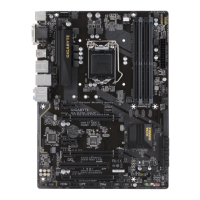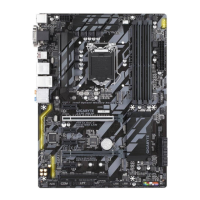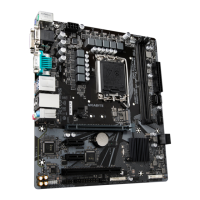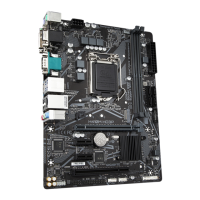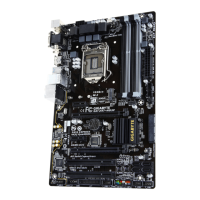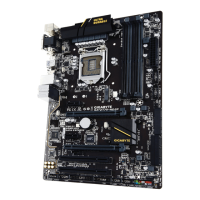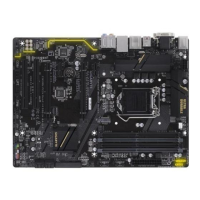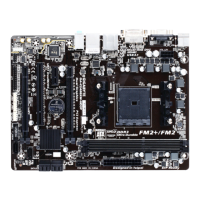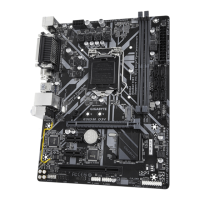Do you have a question about the Gigabyte B360 HD3P and is the answer not in the manual?
Safety guidelines for installing hardware to prevent damage.
Details about CPU, Chipset, Memory, Graphics, LAN, Expansion Slots, Storage, etc.
Step-by-step guide for installing the central processing unit.
Instructions for installing RAM modules.
Guide for installing PCI Express expansion cards.
Explanation of ports and connectors on the motherboard's rear panel.
Details and pinouts for internal motherboard headers and connectors.
Overview of the initial screen displayed when entering BIOS Setup.
Introduction to the main BIOS interface and navigation.
Advanced settings for system frequencies, voltages, and overclocking.
Displays system information and allows setting date, time, and language.
Configuration options for boot devices, security, and system startup behavior.
Settings for onboard devices like graphics, audio, USB, and other controllers.
Configuration options for the motherboard's chipset features and onboard devices.
Settings related to power management, AC BACK, and power-on options.
Options for saving BIOS changes, loading defaults, and exiting the setup.
Step-by-step guide for installing Intel Optane memory.
Instructions for installing motherboard drivers and software.
Safety guidelines for installing hardware to prevent damage.
Details about CPU, Chipset, Memory, Graphics, LAN, Expansion Slots, Storage, etc.
Step-by-step guide for installing the central processing unit.
Instructions for installing RAM modules.
Guide for installing PCI Express expansion cards.
Explanation of ports and connectors on the motherboard's rear panel.
Details and pinouts for internal motherboard headers and connectors.
Overview of the initial screen displayed when entering BIOS Setup.
Introduction to the main BIOS interface and navigation.
Advanced settings for system frequencies, voltages, and overclocking.
Displays system information and allows setting date, time, and language.
Configuration options for boot devices, security, and system startup behavior.
Settings for onboard devices like graphics, audio, USB, and other controllers.
Configuration options for the motherboard's chipset features and onboard devices.
Settings related to power management, AC BACK, and power-on options.
Options for saving BIOS changes, loading defaults, and exiting the setup.
Step-by-step guide for installing Intel Optane memory.
Instructions for installing motherboard drivers and software.
| Non-ECC | Yes |
|---|---|
| Memory channels | Dual-channel |
| Memory slots type | DIMM |
| Number of memory slots | 4 |
| Supported memory types | DDR4-SDRAM |
| Maximum internal memory | 64 GB |
| Supported memory clock speeds | 2133, 2400, 2666 MHz |
| Supported memory module capacities | 16GB |
| Component for | PC |
| Motherboard chipset | Intel® B360 |
| Audio output channels | 7.1 channels |
| Motherboard form factor | ATX |
| Motherboard chipset family | Intel |
| Windows operating systems supported | Windows 10 |
| Processor socket | LGA 1151 (Socket H4) |
| Compatible processor series | Intel Celeron, Intel Core i3, Intel Core i5, Intel Core i7, Intel Pentium |
| Ethernet interface type | Gigabit Ethernet |
| BIOS type | UEFI AMI |
| ACPI version | 5.0 |
| BIOS memory size | 16 Mbit |
| Supported storage drive types | HDD & SSD |
| PCI Express x16 slots | 3 |
| Number of M.2 (M) slots | 2 |
| Number of SATA III connectors | 6 |
| Number of Parallel ATA connectors | 0 |
| USB 3.2 Gen 1 (3.1 Gen 1) connectors | 1 |
| USB 2.0 ports quantity | USB 2.0 ports have a data transmission speed of 480 Mbps, and are backwards compatible with USB 1.1 ports. You can connect all kinds of peripheral devices to them. |
| Depth | 225 mm |
|---|---|
| Width | 305 mm |

